Friday Apr 26, 2024
Friday Apr 26, 2024
Friday, 1 January 2021 00:15 - - {{hitsCtrl.values.hits}}

Sajith Premadasa

Karu Jayasuriya

Ranil Wickremesinghe
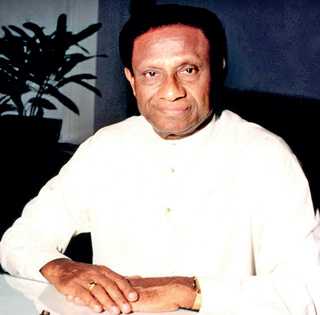
Ranasinghe Premadasa
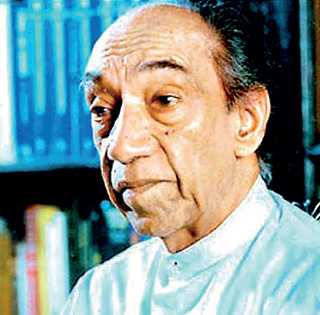
J.R. Jayawardene
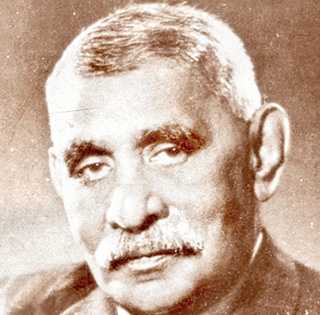
D.S. Senanayake
Though Mr. Dassanayaka’s name rings no bells especially in the absence of the usual photograph, his critique enables me to engage with important issues of perspective regarding the most pressing 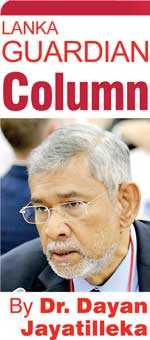 challenge of this time, namely the defence of Sri Lanka’s imperilled democracy which is in transition to despotism, and the retrieval of the democratic space that has been lost.
challenge of this time, namely the defence of Sri Lanka’s imperilled democracy which is in transition to despotism, and the retrieval of the democratic space that has been lost.
Contrary to my critic’s speculation, I am unaware of the ‘key theoretician’ of the SJB and have not been a member of any political party for over 30 years.
I.
My critic writes that “…if SJB, Dayan’s party of choice, is to graduate from being the main Opposition party into the main stakeholder of a ruling coalition, that is only going to be possible with a true commitment to the spirit of democracy and by a building a broad platform that unites all democratic forces against the regime.”
Firstly, this is a trap for the SJB and Sajith Premadasa, in which the “broad platform” gets to decide on the “common” Presidential candidate and the manifesto. Given Harinda B’s article it is very clear who and what he has in mind: either Karu J or a recycling of the nonsensical ‘abolition of the executive Presidency’ slogan.
Secondly, this puts the cart before the horse. The model of successful oppositional politics after a crushing electoral defeat is the UNP of 1973-1977 spearheaded by JR Jayewardene and deputy leader R. Premadasa. The emphasis was by no means on building a broad platform. It was on understanding and admitting the reasons for defeat, dislodging the discredited Old Guard, thoroughly reorganising the party on a new social basis and giving it a new profile. Anything and anyone that reminded the masses of the old Uncle Nephew Party was unceremoniously dumped. The UNP itself became the broad platform.
The UNP’s main ally in 1977 was Mr. Thondaman’s CWC, but that came years after the party’s robust repositioning, reorganisation and consolidation. The priority was on turning the UNP into a totally new party. In the landslide of 1977, the new UNP was both main force and leading force.
II.
The next lesson in the successful defence of democracy is 1988. Ranasinghe Premadasa was not a ‘common candidate’; he was the (uncommon) candidate of the common people.
He was geared up to run independently if deprived of the UNP candidacy, but it was ceded to him. Far from bringing together the broadest reassembly of the discredited, polarising old elements which had caused the crisis and collapse, Premadasa’s election propaganda hardly mentioned the UNP government he had served in; he used the colour orange instead of green; his manifesto ‘A New Vision, A New Deal’ was progressive, radical.
SWRD’s SLFP established itself in 1951, ran for elections in 1952 and formed the winning united front with Philip Gunawardena only in 1955.
Mrs. Bandaranaike’s SLFP formed the winning SLFP-LSSP-CPSL United Front only in 1968 at Bogambara.
Mahinda’s SLPP won the February 2018 local authorities election well before it entered a united front with its old parent party the SLFP. 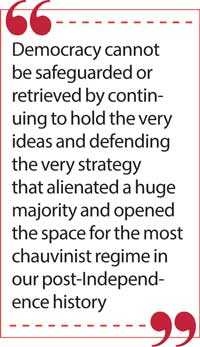
The lesson is simple. You first establish your brand, get your message across, throw the old baggage overboard, demarcate yourself as a new or radically renovated force and build your base, before you form united fronts—or at the least, you give clear priority to the former task than the latter. The model and process must be of concentric circles with the new party as the nucleus, the core, and the united front built around it at the next stage.
My critic writes that “Importantly, both SJB and UNP, however different are they [sic] in scale and how little in thought, form part of the same ideological camp.” Seriously? The failure of the post-Premadasa UNP to win a presidential election and lead the country for a quarter-century proves that the majority of the people of this country, the majority of voters, do not “form part of the same ideological camp” as the UNP. So why should the SJB regard itself as doing so? If it does and the voters think it does, that will ensure the defeat of the SJB too for a good long time. Perhaps that’s what the anti-Sajith camp, a motley crew that wishes to prevent a second Premadasa presidency, would like.
III.
The UNP that my critic wishes to classify in the same ideological camp as the SJB does not even belong in the same ideological camp as the UNP of JR Jayewardene and Ranasinghe Premadasa, in that it calls for the abolition of the executive presidency and therefore the obligation to use this powerful instrument in the service of the people as Premadasa did.
The UNP belongs in the camp of neoliberal globalist elitism, which Jake Sullivan, president-elect Biden’s National Security Advisor has declared a “failure”, calling for “a new economic philosophy”.
Can anyone imagine the UNP of DS Senanayake, JR Jayewardene, Ranasinghe Premadasa or even DB Wijetunga, co-sponsoring a resolution on Sri Lanka in Geneva which is based on and commences with a commendation of a UN High Commissioner’s Report stating that war crimes and crimes against humanity committed during the last war were “systemic” and “systemwide” i.e., not isolated, individual aberrations but deliberate policy?
Ranasinghe Premadasa would have taken a verbal buzz-saw to anyone who used the “Toiyya/Baiyya” dichotomy, not only because it was insulting to the common folk but also because there are many more “Baiyyas’ than “Toiyyas”.
The SJB cannot and must not belong to “the same ideological camp as the UNP”. The biggest danger faced by the SJB is the possibility of the public perception of it being infected by ideological ‘Ranilism’. Simply because the SJB emanated from the UNP it does not inhabit the same ideological space, just as SWRD Bandaranaike’s SLFP, emanating from the UNP, did not share an ideological camp with the UNP.
The people need an alternative to the Gotabayan regime and ideology and decidedly want an alternative that of the UNP of the past quarter-century (of which Ranil, incredibly, remains the leader). The SJB must do what SWRD succeeded in doing: create a new, moderate progressive centre and build a new ideological camp around it.
Given the polarisation between neoliberal globalism and neoconservative tribalism in the world, as represented in Sri Lanka by the UNP and the Gotabaya regime, the SJB must carve out a new ideological space and rebuild a patriotic, rural peasant heartland-friendly (DS Senanayake), multiethnic, social-democratic (Ranasinghe Premadasa) centre-space, aimed in the first place at winning the Executive Presidency (JR Jayewardene) in 2024.
IV.
My public support for Sajith Premadasa and clear advocacy that he lead the UNP and the Opposition dates back over a decade, to early 2010, as evidenced by the pages of the Sunday Leader (The Sajith Solution | The Sunday Leader) and Groundviews (The Opposition in Sri Lanka: Restore viability, resolve crisis – Groundviews). So much for a “changing of camps” by me.
Why didn’t Sajith Premadasa do better than the very respectable 42% he scored? Why couldn’t he do a Premadasa 1988? It has nothing whatsoever to do with a change from his father’s time to the present which my critic alleges Sajith failed to comprehend. It had everything to do with the fact that he was tripped up by the UNP, thereby guaranteeing Gotabaya Rajapaksa’s victory:
(A) Sajith was not given the nomination until after Gotabaya had done several laps around the country as candidate.
(B) Sajith was given the candidacy but not the party leadership as his father had been in 1988.
(C) Gotabaya ran with Mahinda Rajapaksa, the ultimate electoral asset, at his side. Sajith was forced to run with the electoral deadweight and jinx Ranil Wickremesinghe appearing on the platform and on campaign literature and symbols, unlike in 1988 when Ranasinghe Premadasa ran with a clean slate devoid of any sign of the earlier President.
(D) Sajith was saddled with an election manifesto that was a compromise with the UNP’s old Ranil-Mangala thinking, unlike Premadasa’s winning 1988 manifesto ‘New Vision, New Deal’ which was drafted by him and Susil Sirivardhana.
(E) In the midst of a campaign where Sajith ran against an ultranationalist candidate, Mangala Samaraweera tweeted that the MCC would be adopted—while Premadasa in 1988 would never have countenanced anyone in his camp asserting that the IPKF would be retained. Premadasa’s manifesto pledged it would be sent back, thereby neutralising the nationalist advantage of his opponent Madam Bandaranaike whose manifesto contained the same pledge.
V.
Now to the so-called ‘constitutional coup’ of late 2018. As a political scientist of the Realist school, I do not view politics through a narrowly legalist-constitutionalist lens. A ‘coup’ in the political sense is a despotic stroke to stop elections and the exercise of popular sovereignty, while Sirisena’s move, just as Chandrika in 2003 against the same UNP Prime Minister, was to force an election and the exercise of popular sovereignty to resolve a mounting crisis of polarisation.
The Sirisena-Mahinda rapprochement of late 2018 was President Sirisena’s last-ditch attempt to manage a social and political crisis which had clearly manifested itself in the victory of a newly formed party over the two main political parties at the local elections of 2018. Had it worked and an election been held, we would not have had the dangerously polarising Alt-Right candidacy and presidency of Gotabaya Rajapaksa.
Following the UNP’s return to office by end 2018, it continued, aided and encouraged by the TNA and Speaker Karu Jayasuriya, to proceed with the suicidal project of a new Constitution with a Presidential election looming.
I was appalled by Mr. Jayasuriya’s obduracy as Speaker in depriving Mahinda Rajapaksa of the leadership of the Opposition who clearly enjoyed the largest support in the opposition, and granting it to the TNA which had a fraction of that support. If anything lent a huge fillip to the Sinhala sense of a minoritarian conspiracy to displace and deprive them of even the Opposition leadership, this was it.
During and after the 52-day event of 2018, Karu Jayasuriya functioned as if the Speaker was a third political pole, the third centre in the government, challenging the directly-elected President. This was the same Trumpian playbook as in Venezuela where Juan Guido, the puppet pretender to the Presidency (now a nonentity) was propped up by the post of Speaker, and in Brazil where the Speaker succeeded in ousting Lula’s protégé and successor President Dilma Roussef.
These were powerful emotional factors which culminated in a ‘never again’ backlash from the overwhelming majority of the Sinhala majority, resulting in the 20th Amendment and the retrogressive character of the forthcoming Constitution. Sadly, Karu Jayasuriya is identified in the mass mind with the disastrous Ranil Wickremesinghe leadership and his state-weakening project. The populist Sajith Premadasa was far less complicit, which is why he fared better as presidential candidate in November 2019 than Karu Jayasuriya could have in the face of the backlash, just as the populist Ranasinghe Premadasa did vastly better in 1988 against the xenophobic wave than Gamini Dissanayake or Lalith Athulathmudali could have.
VI.
Contrary to the myth of a strong Karu J-civil society movement, there are five identifiable streams in civil society:
(1) The pro-Ranil-Mangala-CBK-KJ stream of neoliberals who were against the war to crush separatist-terrorism (unlike Karu) and are for a non-unitary and non-Presidential state (like Karu). In the Sinhala heartland they are delegitimised and radioactive.
(2) The Sinhala-Buddhist extremists who shouldn’t be touched with a barge-pole.
(3) The independent professionals, including Sinhala patriots, who stood above the partisan political fray or supported one or another camp without being fanatics (e.g., the GMOA).
(4) Progressive civil society represented by the JVP-driven NPP.
(5) Radical civil society gathered around the Frontline Socialist Party.
The priority of a democratic movement should be to draw in categories (3) to (5).
VII.
Having stood by President Ranasinghe Premadasa, and almost lost my life at the hands of an ultranationalist mob at Kanatte for that open, public commitment to the most progressive leader Sri Lanka ever had, my absolute priority after his assassination was the bringing of (Old Testament) justice to Prabhakaran and the Tigers who had been responsible for the murders of some of the finest personalities I had known and worked with—EPRLF founder-leader K Pathmanabha, Lakshman Kadirgamar, Neelan Tiruchelvam, Kethesh Loganathan, Rajani Tiranagama, and above all, President Premadasa himself. For that task the choice was between Mahinda and Ranil which was no choice at all.
VIII.
I have often criticised the TNA for wartime fellow-travelling with the Tigers and unrealistic overreach in the postwar period, but never in forty years of published writing, including two books on Sri Lanka (of a total of four), did I “mistake the TNA for a terror outfit” as Harinda B. dishonestly alleges.
IX.
He adds that I do so “despite himself been (sic) a convict of supporting terrorism, specifically, for ‘conspiring to overthrow the State through violence’ in 1986.” Fact check: I was accused and indicted in absentia of the charge (actually 14 charges under the PTA and the Emergency) but was never tried and convicted, and am therefore not “a convict of supporting terrorism” (sic). He should also note that the main charge he accurately reproduces, namely “conspiring to overthrow the State through violence”, nowhere uses the term “terrorism”. Terrorism is the witting targeting of unarmed civilians. I have never been accused of terrorism, let alone convicted of it.
I rebelled against a regime which had deviated more sharply from democracy than any, before or since. The UNP government of 1977-1988 violently stole the 1981 DDC election in Jaffna and held a fraudulent and coercive island-wide Referendum in December 1982, suspending for an entire six-year term, the holding of the parliamentary elections scheduled for early 1983. With the electoral safety-valves shut down and UNP Minister Cyril Mathew spreading racism for years through publications massively mailed out with the Government seal, Black July 1983 erupted a few months later. The UNP promptly blamed the JVP which was completely innocent of the charge and banned it (over Premadasa’s objections). In 1984, two unarmed university students were shot dead by the Police in Peradeniya and Colombo following a brutally threatening televised speech the previous evening by National Security Minister Athulathmudali (one was murdered by the Police before my eyes, when I was a visiting lecturer at Colombo University).
By its policies and practices in government, the UNP elite had created the extreme crisis which Premadasa (who had repeatedly dissented in Cabinet) dramatically summed up as a “torch flaming at both ends” which had been bequeathed to him when he accepted the candidacy.
X.
Democracy cannot be safeguarded or retrieved by continuing to hold the very ideas and defending the very strategy that alienated a huge majority and opened the space for the most chauvinist regime in our post-Independence history. Projects and personalities that were part of the problem cannot be part of the solution.